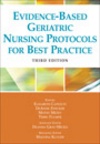Evidence-Based Geriatric Nursing Protocols for Best Practice This title has been archived.

Author: Elizabeth Capezuti, PhD, RN, FAAN, DeAnne Zwicker, MS, APRN, BC, Mathy Mezey, EdD, RN, FAAN, Terry Fulmer, PhD, RN, FAAN
Affiliation: New York University, College of Nursing
Publisher: Springer Publishing Company
Publication Date: 2008
ISBN 10: 0826111033
ISBN 13: 9780826111036
eISBN: 9780826111050
Edition: 3rd
Affiliation: New York University, College of Nursing
Publisher: Springer Publishing Company
Publication Date: 2008
ISBN 10: 0826111033
ISBN 13: 9780826111036
eISBN: 9780826111050
Edition: 3rd
Description:
This is the third edition of the book formerly entitled Geriatric Nursing Protocols for Best Practice. The original project grew from the efforts of these authors and editors, national leaders in geriatric nursing, and the John A. Hartford Foundation Institute for Geriatric Nursing, to improve the quality, outcomes, and cost-effectiveness of health care for the elderly in hospitals, long-term care facilities, and the community. These efforts include influencing both the skills of individual nurses and the quality of the systems in which they are educated and work. This focus on improving geriatric care is driven by the growth in the over-65 population and its impact on the health care system. For example: * Older adults constitute 12% of the US population and 50% of hospital expenditures, 80% of home care visits, and 90% of nursing home care * Older adults are 60% of medical-surgical patients, 46% of critical care patients, and represent 50% of ICU days * 60% of visits to cardiologists and 63% of visits to oncologists are made by patients 65 and over Despite these statistics, too few nurses--or physicians and other health care professionals--are prepared to give comprehensive care to these patients. In this book, each chapter addresses a clinical problem, syndrome, or disease that older adults commonly experience and a distillation of what constitutes "best practice" for that problem, or protocols. The third edition will include 17 revised and updated chapters from the current edition and 15 to 20 new topics including critical care, diabetes, hydration, oral health care, palliative care, and substance abuse. A uniform process will be used to ensure that the information is evidence-based. Each chapter includes educational objectives, assessment of the problem, nursing intervention or care strategies, and references; most chapters have case studies. The protocols in the text have been tested by nurses in the more than 200 participa.
Related Titles
